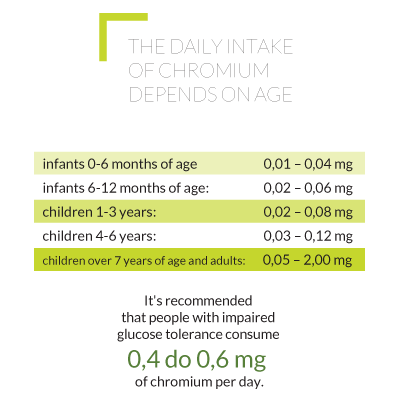
Chromium is a chemical element discovered in 1797 by the French chemistry professor Louis Nicolas Vauquelin. It belongs to the group of transition metals, and its name comes from the Greek word “colour”, as depending on the degree of oxidation, it forms compounds in various colours. For the human body, chromium is important in oxidation state III.
Chromium in the third state of oxidation is of particular importance for human health and good physical and mental wellbeing. Other chromium compounds, particularly at state VI, have harmful effects on living organisms: they’re toxic and mutagenic for cells, and contribute to the formation of tumours.
Chromium III is an extremely important element that plays an active part in our health. It belongs to the group of bioelements, i.e. minerals that are present in the body in an amount greater than 0.01%, such as calcium, magnesium, phosphorus, chromium and sulphur. Bioelements perform many important regulatory, structural and transmission functions in the body, and thus are crucial for life.
It has been calculated that there’s a maximum of 6 mg of chromium present in the body of an adult. Even so, it’s essential in many metabolic processes. One of the most important tasks of chromium is its participation in glucose metabolism. It stimulates pancreatic cells to produce insulin, and plays an active role in the metabolism of carbohydrates, fats and proteins. It also lowers the blood level of bad cholesterol (LDL) and increases the level of good cholesterol (HDL).
Trivalent chromium protects blood vessels and other tissues in the body. It stimulates glucose and amino acid transport to muscle cells and inhibits catabolic enzyme activity. Chromium is part of some enzymes, e.g. trypsin. It also supports the building of muscle tissue and improves muscle strength.

Because chromium takes part in insulin metabolism, it’s extremely important for diabetics and the elderly, who are often deficient in this element. It’s an important component of GTF (Glucose Tolerance Factor), which is a chemical substance produced in the liver and released into the blood when glucose or insulin increases. The activity of chromium reduces sweet cravings and hunger, which is particularly important for overweight people and those trying to lose weight.
A well-balanced diet usually provides the body with the right amount of chromium. However, a poor, repetitive diet containing highly processed products may result in a chromium deficiency in the body.
Elemental hair analysis is a test that accurately reflects the content of specific elements in the body. The EHA test shows us whether supplements that contain chromium are needed, and whether the body has harmful substances present, such as heavy metals.
Elemental hair analysis also shows the synergistic and antagonistic relationships between specific elements in the body. The synergistic effect occurs mainly at the metabolic level, and means that an adequate supply of one element to the body improves the absorption (metabolism) of another. In contrast, antagonism takes place where the excessive consumption of one element can inhibit the absorption of another ingredient. For example, high levels of calcium are maintained in the body, e.g. due to high dietary intake or supplementation of calcium. Excess calcium reduces the intestinal absorption of zinc. In turn, incorrect zinc levels result in excessive copper absorption, which in its toxic form can lead to poisoning of the body. Because of similar symptoms, such poisoning is often thought to be iron deficiency and leads to deterioration of blood results.
Taking too much chromium can lead to poisoning of the body. So when supplementing, follow the manufacturer’s instructions provided in the leaflet or on the packaging.
Elżbieta Rymar, Ważny nie tylko dla diabetyków chrom – biopierwiastek niezbędny do życia, [It’s not only diabetics who need CHROMIUM – it’s an element essential for life] DietPoint, 1(2)/2019, s. 41-42.















